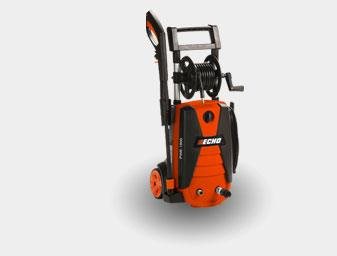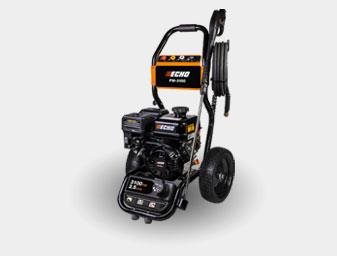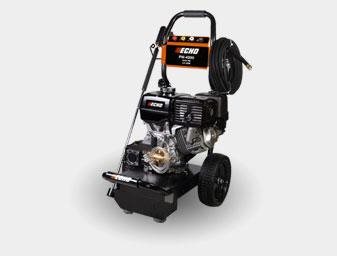Pressure Washing Your House
Your home says a lot about you. It’s the first impression people get of you and your lifestyle when they visit. Keeping it pristine and looking sharp is not just important—it’s a way to show how much you care. Dirt, grime, mold, and mildew are common on houses, and they do more than just diminish your home’s appearance. Over time, they can degrade the exterior of even the best-built houses. They can affect your siding, brick, or stucco and threaten a structure’s integrity. Fortunately, pressure washing a house is a quick and effective way to boost curb appeal and protect your home and yard.
Read on to learn everything you need to know about how to pressure wash your house, from choosing the right equipment to safety tips and more.
Choosing the Right Pressure Washer
Learning how to clean the outside of a house with a pressure washer isn’t difficult, but you want to have the best tools to ensure you get the job done right. Professional-grade equipment from ECHO gives you the power and precision you need to tackle any pressure washing job. Whether you’re a Yarder or a professional landscaper, a durable pressure washer makes life easier and any structure or property more beautiful.
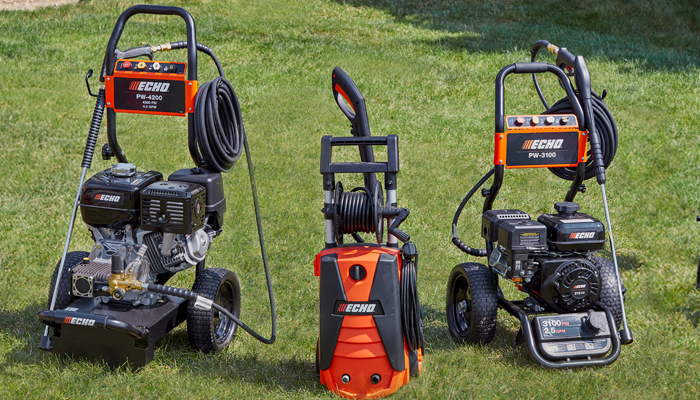
Before you buy a new pressure washer, think about the following:
Pounds per square inch (PSI): When using a pressure washer for a house exterior, 1,800–3,000 PSI is typically recommended. Lower PSI means gentler pressure, which can be important if you’re washing any delicate surfaces or siding. You would use a higher PSI for removing stubborn grime, dirt, and mildew.
Gallons per minute (GPM): High GPM offers a wider cleaning path, which can reduce the time and effort you need to clean.
Power source: Do you prefer gas-powered, electric, or battery-powered pressure washers? ECHO’s gas-powered PW-4200 delivers the power you need to pressure wash large homes or complete demanding jobs. If you’re looking for something in the middle, our PW-3100 is another gas-powered option that’s ideal for cleaning decks, patios, walkways, homes, or cars.
Accessories: You can choose from a variety of accessories for your new pressure washer. From nozzles and replacement hoses to spray guns and spray wands, you can customize and upgrade your equipment to fit your needs, so you can get every job done.
How to Pressure Wash Your House
Pressure washing your house isn’t hard, but the following step-by-step directions will help you get the job done as quickly and thoroughly as possible.
Prepare the Surrounding Areas
Like most projects, prepping is key. Before you start pressure washing your home or any outdoor spaces, make sure to cover or protect anything that shouldn’t get wet or blasted.
Tips for preparing to pressure wash an outdoor area include:
Check the weather forecast to ensure you’re not going to be competing with inclement weather.
Use plastic sheets or drop cloths to protect delicate foliage from harsh spraying or exposure to chemicals or detergents.
Shut doors, windows, and vents tightly to keep water or detergent from entering areas they shouldn’t.
Move outdoor and patio furniture, grills, or other decorations away from the areas you’re spraying.
Turn off or cover electrical outlets or lights.
Sweep or blow loose debris and dirt away.
Pretreat stubborn stains or marks.
Wear non-slip, waterproof footwear.
Select the Right Nozzle & Detergent
Having the right gear for the job is one of the secrets to getting the most from your pressure washer. The right nozzle and detergent enhances performance for the best results. Pressure washer nozzles are available in many varieties, and each one is designed for specific purposes and surfaces.
Red (0°): Creates a pinpoint blast suitable for treating difficult stains. Should be used sparingly as this spray power risks surface damage if used improperly.
Yellow (15°): Ideal for heavy-duty cleaning, like when spraying heavily soiled walkways or brick.
Green (25°): Sufficient for general-purpose washing, like when spraying siding, fencing, or decks.
White (40°): Gentle enough for even delicate surfaces, recommended for cleaning wood or vinyl siding.
Black nozzle (65°/soap): Should be used when applying detergents. Using a specialized soap nozzle ensures surfaces are evenly covered, maximizing your cleaning efforts.
Start from the Bottom & Work Your Way Up
Although you might think you should start at the top and work your way down, seasoned Yarders and landscaping pros know the trick to pressure washing a home is always starting at the bottom. This lets you pre-wash lower areas and prevents streaking from any runoff.
Use slow, controlled movements and sweep the pressure wand from side to side. Focus on keeping a safe distance (about 6 to 12 inches) from the surface you’re washing.
Rinse from the Top Down
Once loose debris is removed, it’s time to rinse. This time, you should start at the top of your surface area and work downward. Let gravity help prevent dirty water from dripping onto your clean, freshly washed areas. Use overlapping strokes that are consistent to ensure detergent is thoroughly washed away. Giving a final rinse is always a good idea to make sure nothing is left behind except your spotless surface.
Repeat for Tough Stains
If you’re dealing with stubborn mold, mildew, or deeply embedded deposits of debris, you might have to reapply detergent and give it some time to penetrate the surface. This generally takes no longer than 5 to 10 minutes, but you should check your detergent label. If stains still persist, you can also use a brush or try a more powerful nozzle, as long as it’s safe for the material you’re washing.
Brick: Use a 15° nozzle and a masonry-friendly detergent or cleaner.
Stucco: Use a wider 40° nozzle and keep your spray a safe distance to avoid damaging the stucco.
Wood: Start with the 40° nozzle to avoid damaging the wood.
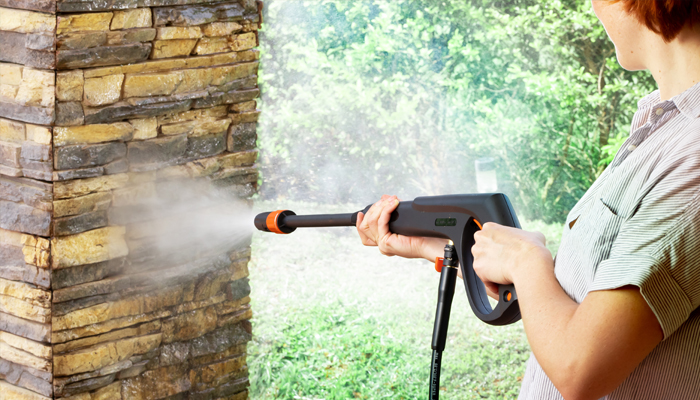
Finishing Up & Drying
As you complete your job, your surfaces are clean, and any detergent is rinsed thoroughly, you can let nature do the rest. Letting your home air dry can take a couple of hours, depending on the climate you’re working in. Once every area is completely dry, you can replace any patio furniture, outdoor cushions, grills, or decorations you removed during your prep phase.
Remember that patience pays off. Allowing your exterior to dry completely helps prevent mildew or mold regrowth.
Safety Tips for Pressure Washing a House
Power tools and equipment use force that should be respected to ensure safety. ECHO power tools offer professional-grade reliability and precision, but there are still some safety tips to keep in mind:
Don’t use high-pressure nozzles on fragile surfaces.
Look up recommendations for the material type you’re pressure washing.
Never spray directly at electrical outlets, fixtures, or power lines.
Check the surfaces you’re planning to wash to make sure they can withstand the process. If you notice flaking paint, rotted wood, or loose siding, you may need to make some minor repairs before starting your project.
Always wear proper eye and other personal protection equipment (PPE).
Don’t use a pressure washer while standing on a ladder. Instead, attach a telescoping wand for ultimate safety.
Make sure pets and children are far away from your work area.
Consult your manufacturer’s instructions about what type of detergent you should use in your pressure washer.
Additional Tips for Pressure Washing Success
Some final tips before you start your next pressure washing job include:
Test a small area before tackling large surfaces.
It’s OK to use cleaning solutions generously, but don’t let them dry on your surface.
Using overlapping, sweeping motions offers the best coverage and will prevent streaks.
If possible, try to work on an overcast day or in the shade to prevent work areas from drying and streaking.
If you’re pressure washing the side of your house, cleaning gutters ahead of time prevents dirt and runoff during the next rainfall.
Make sure to do basic maintenance on your pressure washer. You should flush out detergents and inspect hoses before and after each use.
Store your pressure washer in a cool, dry place.
Pressure washing a house offers many benefits, including enhanced curb appeal, protection from mold and mildew, and a general extended lifespan of your home’s exterior surfaces. Choosing the right pressure washer is essential, and now you know exactly what to look for.
Ready to transform your home and outdoor spaces? Explore ECHO’s full lineup of professional-grade pressure washers today and take that first step in maintaining a home that consistently looks pristine, clean, and well-cared for.
